高中英语同步教案:UnitGlobalwarming人教新课标选修_6
高中英语Unit4GlobalwarmingReading教案新人教版选修6(2021年整理)

(完整)高中英语Unit4GlobalwarmingReading教案新人教版选修6(word 版可编辑修改)编辑整理:尊敬的读者朋友们:这里是精品文档编辑中心,本文档内容是由我和我的同事精心编辑整理后发布的,发布之前我们对文中内容进行仔细校对,但是难免会有疏漏的地方,但是任然希望((完整)高中英语Unit4GlobalwarmingReading教案新人教版选修6(word版可编辑修改))的内容能够给您的工作和学习带来便利。
同时也真诚的希望收到您的建议和反馈,这将是我们进步的源泉,前进的动力。
本文可编辑可修改,如果觉得对您有帮助请收藏以便随时查阅,最后祝您生活愉快业绩进步,以下为(完整)高中英语Unit4GlobalwarmingReading教案新人教版选修6(word版可编辑修改)的全部内容。
Unit 4 Global warmingReadingTeaching goalsTarget languagewords and phrases:energy, light(v.), heat(v.), renewable, non—renewable, run out, compare,phenomenon, graph, fuel, trap, data, climate, catastrophe, consequence, range,per, glance, compare to, come about, fierce debate, result in, build up, keep on Ability goalsEnable the students to talk about different sources of energy.Enable the students to read the text, understand what it is about and talk about the causes and effects of global warming.Teaching important & difficult pointsEnable the students to get a better understanding of articles of this kind。
人教版选修六Unit4《Globalwarming》word教案1

Teaching Plan for Unit 4 Global Warming (1st period)设计思路:教材分析:本课文取自于人教版新教材选修6 Unit 4,文章篇幅较长,题材属于科普类文章。
科普类文章内容较为枯燥,术语、生僻词较多,学生读起来较有困难。
好在文章话题——全球变暖的问题已为公众熟知,学生对此话题并不陌生,这一点有利于教学。
学情分析:学生是外国语学校学生,语言基础和能力水平较高,这对教学活动的展开很有帮助;但是授课者从未接触过这些学生,对他们的实际情况几乎一无所知,且上海和江西同级别的重点学校的学生水平并不一致,这给授课者在预估学生能力方面产生较大的障碍,给备课带来极大的困难。
另外,本节课因特殊原因只有35分钟,这是本堂课最难解决的问题。
授课者不得不考虑既要将文本作适当的阅读处理又要有适当的拓展,以及保证课堂的完整性的问题。
上课框架:本堂课是这篇课文的第一课时,以学生掌握文章的主旨和具体内容为主要目标。
文章标题“The earth is getting warmer but does it matter?”非常清楚地告诉了我们文章将阐述地球在不断变暖的事实,并提出疑问这究竟有没有关系?因此,本课大体分两部分进行:第一部分处理地球正在变暖的原因和事实依据,第二部分则带领学生阅读“这是否有关系”,并引发自己的思考。
因此,我设计了6个任务来完成本堂课的阅读教学。
其中五个任务以文本为基础,通过带读、自读、互相读的方式,学生利用predicting、scanning、skipping等阅读技巧来完成文本阅读,了解主旨,熟悉文章内容,抓取相关信息。
最后一个活动为讨论,使学生明白全球变暖问题日趋严重,我们还是要有应对措施,并加强环保意识。
Teaching materials:Textbook---Student’s Book 6, New Senior English for China, People’s Education Press Teaching Aids: a blackboard, a multimedia kitObjectives:I.Of Knowledge:Students will know basic scientific facts concerning global warming, scientist s’differentattitudes towards it and the writer’s opinion as well.II.Of AbilityA.Students will continue to develop their predicting skill to guess the main idea of the articleand get prepared for the reading.B.Students will practice the scanning skill to get the specific information.C.Students will learn to think critically about the problems the writer has raised.III.Of EmotionA.Students will learn we should conserve energy and protect the earth.B.Students will want to get involved in the classroom activities when doing the tasks.Procedures:I.Before ReadingLead-inA graph which shows the changes of the average temperatures of Jiangxi Province from 1959 to 2006. What can you tell from the graph? (Students’ answer may vary.)This leads to our topic today---Global warming.1. Predicting:1)What can you infer from the title?2)What are the two graphs about?II. While Reading(To make sure we are always on the same page, please mark each paragraph by writing Para. 1, Para. 2…in front of each paragraph. How many paragraphs do we have?)2. Scanning1)Look for people’s names. Circle them with a red pen.①Who wrote the magazine article?②What are the names of the three scientists mentioned in the article?2)Para. 1 & 2①What has caused global warming? (vocabulary teaching involved)②Which sentence tells us what the writer will talk about in the article?3.Reading: Para. 3, 4&5How has this come about?Further questions:1)Can you give the three examples of the fossil fuels?2)Who gave us scientific evidence that the amount of carbon dioxide has been increasing?3)Some gases can trap heat from the sun. What do scientists call this phenomenon?What would happen if there were no greenhouse effect? What would happen if there were too many greenhouse gases?4)How high will the temperature increase go according to Janice Foster?4.Reading: Does it matter? Pair Work (Para. 6)The students sitting on my left hand side will read about Janice Foster while the others will read about George Hambley. Then fill in the blanks in the table concerning your reading part. Exchange information with your desk mate so that he/she can fill in the other half.5. Reading: Para. 71)The writer probably thinks ________.A. It matters.B. It doesn’t matter.2) What probably does the writer want us to do by the last two questions? III. Post Reading6. Group Discussion: What can/should we do?•At home/work/school•Clothing /food/ housing/ transportation •Policies, laws, finance•Media, transportation, design ofbuildings•You may also refer to the pictures on Page 25.Make a list:(Summary: Wrap up the topic)IV. Homework:1.Read the text again and finish Comprehending 1&2 on Page 27.2.Choose sides and prepare for a mini debate on whether we should something about globalwarming. You may refer to the following websites.①/pub_display.php?pub_id=2872②/xiawf001/default.html?page=5③/global-warming-positives-negatives.htm3. Underline important words and phrases.。
Unit 4 Global Warming 教学设计1-公开课-优质课(人教选修6精品)
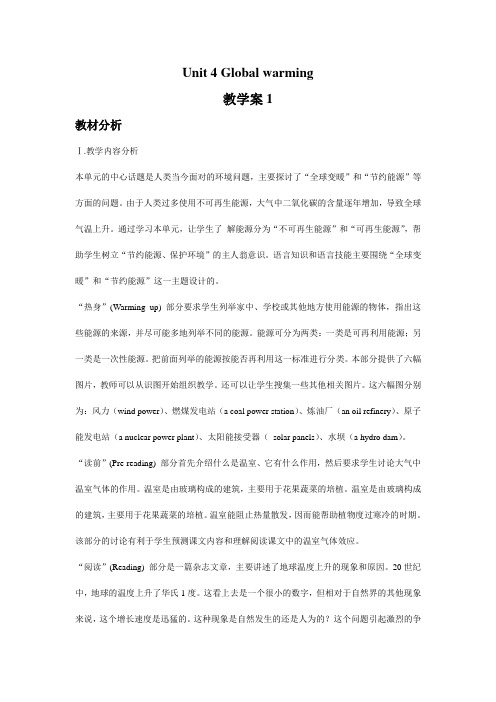
Unit 4 Global warming教学案1教材分析Ⅰ.教学内容分析本单元的中心话题是人类当今面对的环境问题,主要探讨了“全球变暖”和“节约能源”等方面的问题。
由于人类过多使用不可再生能源,大气中二氧化碳的含量逐年增加,导致全球气温上升。
通过学习本单元,让学生了解能源分为“不可再生能源”和“可再生能源”,帮助学生树立“节约能源、保护环境”的主人翁意识。
语言知识和语言技能主要围绕“全球变暖”和“节约能源”这一主题设计的。
“热身”(Warming up) 部分要求学生列举家中、学校或其他地方使用能源的物体,指出这些能源的来源,并尽可能多地列举不同的能源。
能源可分为两类:一类是可再利用能源;另一类是一次性能源。
把前面列举的能源按能否再利用这一标准进行分类。
本部分提供了六幅图片,教师可以从识图开始组织教学。
还可以让学生搜集一些其他相关图片。
这六幅图分别为:风力(wind power)、燃煤发电站(a coal power station)、炼油厂(an oil refinery)、原子能发电站(a nuclear power plant)、太阳能接受器(solar panels)、水坝(a hydro dam)。
“读前”(Pre-reading) 部分首先介绍什么是温室、它有什么作用,然后要求学生讨论大气中温室气体的作用。
温室是由玻璃构成的建筑,主要用于花果蔬菜的培植。
温室是由玻璃构成的建筑,主要用于花果蔬菜的培植。
温室能阻止热量散发,因而能帮助植物度过寒冷的时期。
该部分的讨论有利于学生预测课文内容和理解阅读课文中的温室气体效应。
“阅读”(Reading) 部分是一篇杂志文章,主要讲述了地球温度上升的现象和原因。
20世纪中,地球的温度上升了华氏1度。
这看上去是一个很小的数字,但相对于自然界的其他现象来说,这个增长速度是迅猛的。
这种现象是自然发生的还是人为的?这个问题引起激烈的争论。
许多科学家认为,这种变化是人类燃烧矿物燃料所致。
高中英语选修6 unit4 global warming教案(人教新课标)
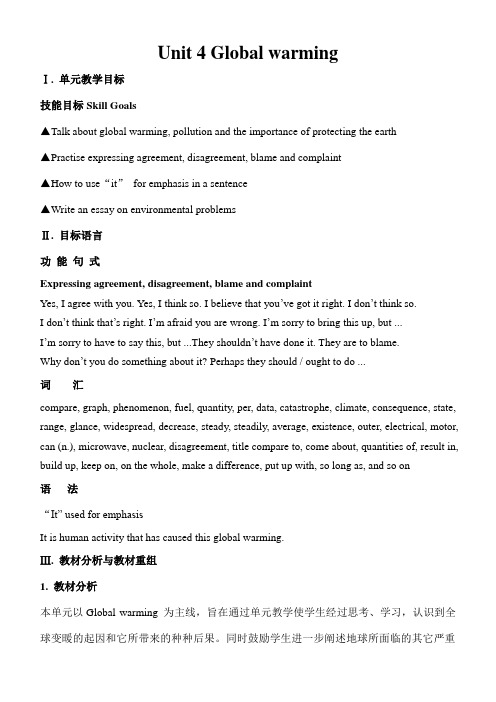
Unit 4 Global warmingⅠ. 单元教学目标技能目标Skill Goals▲Talk about global warming, pollution and the importance of protecting the earth▲Practise expressing agreement, disagreement, blame and complaint▲How to use“it”for emphasis in a sentence▲Write an essay on environmental problemsⅡ. 目标语言功能句式Expressing agreement, disagreement, blame and complaintYes, I agree with you. Yes, I think so. I believe that you’ve got it right. I don’t think so.I don’t think that’s right. I’m afraid you are wrong. I’m sorry to bring this up, but ...I’m sorry to have to say this, but ...They shouldn’t have done it. They are to blame.Why don’t you do something about it? Perhaps they should / ought to do ...词汇compare, graph, phenomenon, fuel, quantity, per, data, catastrophe, climate, consequence, state, range, glance, widespread, decrease, steady, steadily, average, existence, outer, electrical, motor, can (n.), microwave, nuclear, disagreement, title compare to, come about, quantities of, result in, build up, keep on, on the whole, make a difference, put up with, so long as, and so on语法“It” used for emphasisIt is human activity that has caused this global warming.Ⅲ. 教材分析与教材重组1. 教材分析本单元以Global warming 为主线,旨在通过单元教学使学生经过思考、学习,认识到全球变暖的起因和它所带来的种种后果。
人教版高中英语选修6教案Unit 4 Global warming

人教版高中英语选修6教案Unit 4Global warmingUnit4Globalwarming一、语言要点I单元要点预览(旨在让同学整体了解本单元要点)词汇部分词语辨析1.consequence/result/effect/outcome2.glance/gaze/glare/stare词形变化1.agreev.同意disagreev.不同意agreement/disagreementn.同意/不同意2.existv.存在existencen.存在3.statev.陈述,说明statementn.声明,阐述4.environmentn.环境environmentaladj.周围的,环境的environmentalistn.环境保护主义者重点单词1.phenomenonn.現象2.tendvt.趋向,往往是;照管,护理3.statevt.声明,陈述4.rangen.行列,范围;vt.排列,归类于5.averageadj.平均的6.existencen.生存7.advocate倡导,拥护8.refreshv.精神振作,精力恢复,更新9.contributionn.捐献,贡献,投稿重点词组comeabout发生quantitiesof大量的resultin导致beopposedto反对onbehalfof代表……一方putupwith忍受;容忍solongas只要重点句子1.Somebyproductsofthisprocessarecalled“greenhouse”gases,themostimportantoneofwhichiscarbondioxide.这个升温过程的一些副产品就叫“温室”气体,其中最重要的就是二氧化碳.重点语法it的用法(II)II词语辨析1).consequence/result/effect/outcome【解释】consequence强调因某件事而引起的后果,有时带贬义。
人教版高中英语选修6教案Unit 4 Global warming

人教版高中英语选修6教案Unit 4Glbal aringUnit4Glbalaring一、语言要点I单元要点预览(旨在让同学整体了解本单元要点)词汇部分词语辨析1nsequene/result/effet/ute2glane/gaze/glare/stare词形变化1agreev同意disagreev不同意agreeent/disagreeentn同意/不同意2existv存在existenen存在3statev陈述,说明stateentn 声明,阐述4envirnentn环境envirnentalad周围的,环境的envirnentalistn环境保护主义者重点单词1phenennn現象2tendvt趋向,往往是;照管,护理3statevt声明,陈述4rangen行列,范围;vt排列,归类于averagead平均的6existenen生存7advate倡导,拥护8refreshv精神振作,精力恢复,更新9ntributinn捐献,贡献,投稿重点词组eabut发生quantitiesf大量的resultin导致beppsedt反对nbehalff代表……一方putupith忍受;容忍slngas只要重点句子1Sebprdutsfthispressarealled “greenhuse”gases,thestiprtantnefhihisarbndixide这个升温过程的一些副产品就叫“温室”气体,其中最重要的就是二氧化碳重点语法it的用法(II)II词语辨析1)nsequene/result/effet/ute【解释】nsequene强调因某事而引起的后果,有时带贬义。
result普通用语,指某行动,计划或事带来的最终结果。
effet与相对,指动作行为带来的后果或效应。
ute侧重某项活动,比赛的结果,结局【练习】选择nsequene/result/effet或ute并用其适当的形式填空1)The________fthegaeasbendurexpetatin2)The_________ ftheeetingasthatnneshuldbedisissed3)Theadvertiseent shaveuh________nnsuers’hie4)In_________flaziness,heasfiredes:1)ute2)result3)effet4)nsequene2)glane/gaze/glare/stare看,注视【解释】glane一瞥,匆匆一看,强调动作的短暂gaze凝视,注视,因惊异或赞赏而长时间无意识地凝视某人或某事物glare怒视,带有敌对或威胁的态度stare盯着看,含有无礼或粗俗的意味。
人教新课标选修六Unit4Globalwarming同步学案

细 节 问题 花 费了委员 会 的宝贵 的时 间 。 【 拓展】
c o n s u me t i m e 消 耗 时 间
b e c o n s u m e d w i t h 为f 某种 思想 1 而 不 断 受 折磨 c o n s u me a w a y毁掉 : 毁 灭
Mo r e a n d mo r e me mb e r s a r e r e f us i ng t o
ma n k i n d i t s e l f ,wi t h i t s o wn wa y o f u s i n g a nd a bu s i n g t h e p l a n e t Ea r t h ? We t hi n k i t do e s n o t r e a l l y ma t t e r ,b e .
或 砍伐 森林 并将 其 焚烧 时 . 往 往 产生二 氧 化 碳 等 多种 温 室气体 . 由于这 些温 室 气体 对 来 自太 阳辐射 的 可见 光具 有 高度 的 透过 性 . 而 对 地 球反 射 出来 的 长 波辐 射 具 有 高度 的 吸 收性 , 也 就 是 常说 的 “ 温 室效应 ” . 从 而 导 致 全 球 气候 变 暖 全 球 变暖 会 使 全 球 降 水 量 重
f 0 r t h i s d a n g e r o u s p h e n o me n o n :wh a t a r e t he
d o c u m e n t .总统 已签 署 了一份新 文件 。
S o me p e o p l e s u b s c r i b e d a t e n t h o f t h e i r
h o u r s o f t h e c o mm i t t e e ’ S v a l u a b l e t i m e . 争 论
人教版选修六Unit4《Global warming》word教案2
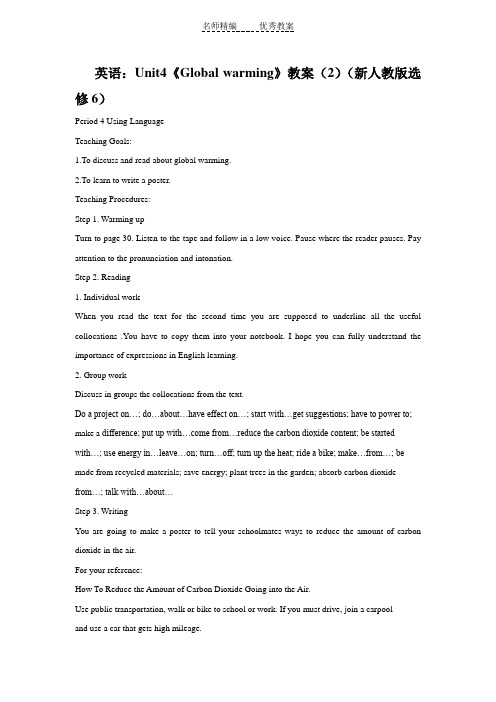
英语:Unit4《Global warming》教案(2)(新人教版选修6)Period 4 Using LanguageTeaching Goals:1.To discuss and read about global warming.2.To learn to write a poster.Teaching Procedures:Step 1. Warming upTurn to page 30. Listen to the tape and follow in a low voice. Pause where the reader pauses. Pay attention to the pronunciation and intonation.Step 2. Reading1. Individual workWhen you read the text for the second time you are supposed to underline all the useful collocations .You have to copy them into your notebook. I hope you can fully understand the importance of expressions in English learning.2. Group workDiscuss in groups the collocations from the text.Do a project on…; do…about…have effect on…; start with…get suggestions; have to power to; make a difference; put up with…come from…reduce the carbon dioxide content; be started with…; use energy in…leave…on; turn…off; turn up the heat; ride a bike; make…from…; be made from recycled materials; save energy; plant trees in the garden; absorb carbon dioxide from…; talk with…about…Step 3. WritingYou are going to make a poster to tell your schoolmates ways to reduce the amount of carbon dioxide in the air.For your reference:How To Reduce the Amount of Carbon Dioxide Going into the Air.Use public transportation, walk or bike to school or work. If you must drive, join a carpooland use a car that gets high mileage.● Use energy-efficient appliances and weatherize your home.●Use renewable energy sources, like solar heart or wind power ,which don’t emit carbon dioxide.● Switch from coal and oil to natural gas in power plants and factories .Natural gas releases the least amount of carbon dioxide.Step 4. Listening and discussingNow turn to page 31. Li Ben is doing an interview with Professor Chen about the use of different sources. Read the statements and listen to the tape recording of the interview to decide which statement the professor does not agree with.We’ll have to stop using fossil fuels.About 90% of the world’s energy comes from fossil fuels.We can replace fossil fuels with renewable sources of energy.Nuclear power is a good source of energy.In the future, we’ll need new technologies to replace fossil fuels.It’s the developed countries who are to blame for producing most of the carbon dio xide.Step 5. Closing downDiscuss what we individuals can do about global warming in groups of four.Step 6. HomeworkMake a poster for your school that tells Ss various ways they can reduce the amount of carbon dioxide in the air.。
人教版选修六Unit 4 Global warming教案
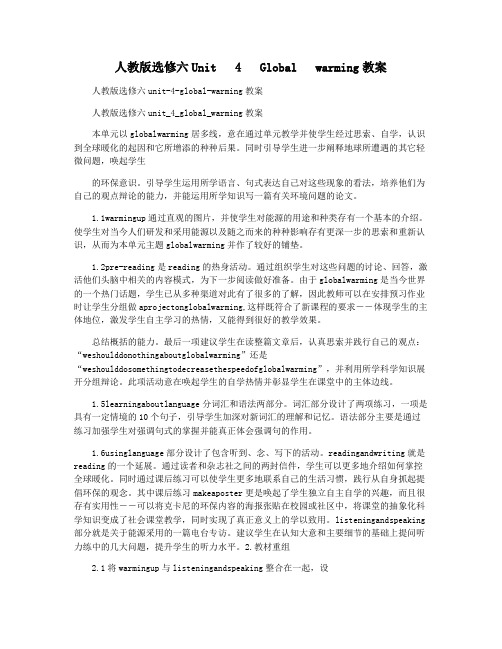
人教版选修六Unit 4 Global warming教案人教版选修六unit-4-global-warming教案人教版选修六unit_4_global_warming教案本单元以globalwarming居多线,意在通过单元教学并使学生经过思索、自学,认识到全球暖化的起因和它所增添的种种后果。
同时引导学生进一步阐释地球所遭遇的其它轻微问题,唤起学生的环保意识。
引导学生运用所学语言、句式表达自己对这些现象的看法,培养他们为自己的观点辩论的能力,并能运用所学知识写一篇有关环境问题的论文。
1.1warmingup通过直观的图片,并使学生对能源的用途和种类存有一个基本的介绍。
使学生对当今人们研发和采用能源以及随之而来的种种影响存有更深一步的思索和重新认识,从而为本单元主题globalwarming并作了较好的铺垫。
1.2pre-reading是reading的热身活动。
通过组织学生对这些问题的讨论、回答,激活他们头脑中相关的内容模式,为下一步阅读做好准备。
由于globalwarming是当今世界的一个热门话题,学生已从多种渠道对此有了很多的了解,因此教师可以在安排预习作业时让学生分组做aprojectonglobalwarming,这样既符合了新课程的要求――体现学生的主体地位,激发学生自主学习的热情,又能得到很好的教学效果。
总结概括的能力。
最后一项建议学生在读整篇文章后,认真思索并践行自己的观点:“weshoulddonothingaboutglobalwarming”还是“weshoulddosomethingtodecreasethespeedofglobalwarming”,并利用所学科学知识展开分组辩论。
此项活动意在唤起学生的自学热情并彰显学生在课堂中的主体边线。
1.5learningaboutlanguage分词汇和语法两部分。
词汇部分设计了两项练习,一项是具有一定情境的10个句子,引导学生加深对新词汇的理解和记忆。
新人教选修六 Unit 4 Global warming单元教学设计
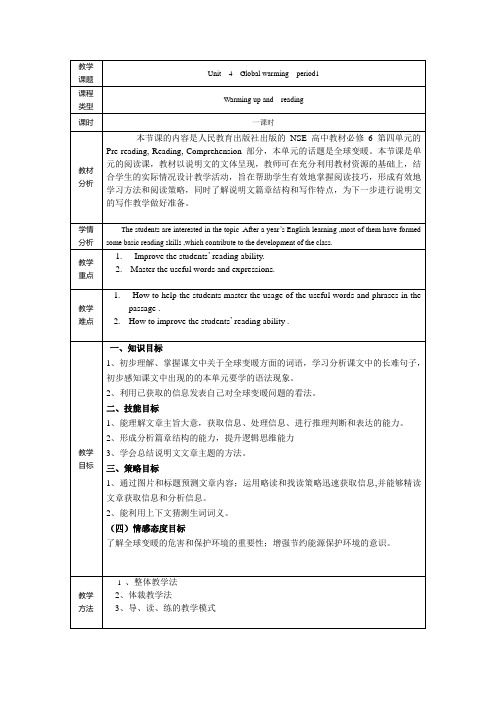
1consume v.消费,消耗;吃完;喝光Make a list of the things that consume energy in your home ,school ,or any other places you can think of.列举一些在家里、学校里或者其他你能想到的地方消耗能量的东西。
(回归课本)用法点拨The car consumes a lot of fuel.这辆汽车很费燃料。
She consumed the big cake.她把那块大蛋糕吃光了。
归纳拓展consumer n .消费者consumption n .消费(量),消耗(量) time-consuming adj .耗费时间的 consumer goods(家用)消费品consuming adj .使人全神贯注的;强烈的 翻译句子(1)新的灯泡耗电量更小。
The_new_light_bulbs_consume_less_electricity. (2)足球让许多孩子都非常着迷Football_is_a_consuming_passion_for_lots_of_kids.2matter v.要紧,有重大关系So how has this come about and does it matter?那么这是如何产生的,有什么要紧吗?(回归课本) 用法点拨⎩⎪⎨⎪⎧⎭⎪⎬⎪⎫It doesn ’t matter to me It matters nothing to me It makes no matter to me whether he is satisfied. 他满意与否对我关系不大(不重要)。
归纳拓展matter 可用作名词,意为“物质,物品;要紧,重要性;问题,毛病(与with 连用)”。
organic (inorganic) matter 有机(无机)物 Any kind of matter has three states. 任何物质都有三种状态。
英语:unit 4 《global warming 》教案-reading(新人教版选修6).doc
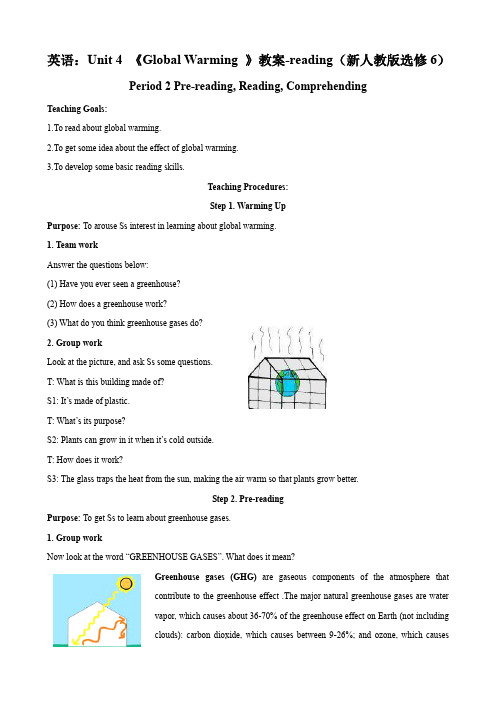
英语:Unit 4 《Global Warming 》教案-reading (新人教版选修6)Period 2 Pre-reading, Reading, ComprehendingTeaching Goals:1.To read about global warming.2.To get some idea about the effect of global warming.3.To develop some basic reading skills.Teaching Procedures:Step 1. Warming UpPurpose: To arouse Ss interest in learning about global warming.1. Team workAnswer the questions below:(1) Have you ever seen a greenhouse?(2) How does a greenhouse work?(3) What do you think greenhouse gases do?2. Group workLook at the picture, and ask Ss some questions.T: What is this building made of?S1: It’s made of plastic.T: What’s its purpose?S2: Plants can grow in it when it’s cold outside.T: How does it work?S3: The glass traps the heat from the sun, making the air warm so that plants grow better.Step 2. Pre-readingPurpose: To get Ss to learn about greenhouse gases.1. Group workNow look at the word “GREENHOUSE GASES”. What does it mean?Greenhouse gases (GHG) are gaseous components of the atmosphere thatcontribute to the greenhouse effect .The major natural greenhouse gases are watervapor, which causes about 36-70% of the greenhouse effect on Earth (not includingclouds): carbon dioxide, which causes between 9-26%; and ozone, whichcausesbetween 3-7%(note that it is not really possible to assert that such-and-such a gas causes a certain percentage of the GHE, because the influences of the various gases are not additive .The higher ends of the ranges quoted are for the gas alone ;the lower end ,for the gas counting overlaps).Naturally occurring greenhouse gases include water vapor, carbon dioxide, methane, nitrousoxide, and ozone. Certain human activities, however, add to the levels of most of these naturally occurring gases.Very powerful greenhouse gases that are not naturally occurring include hydrofluorocarbons(HFCs), perfluorocarbons (PFCs), and sulfur hexafluoride (SF6), which are generated in avariety of industrial processes.Each greenhouse gas differs in its ability to absorb heat in the atmosphere. HFCs and PFCsare the most heat-absorbent.2. Individual workGet Ss to answer these questions individually. Then let them discuss the answers.(1) Who wrote the magazine article? What is the name of the magazine?(2) What are the names of the three scientists mentioned in the article?(3) What do they think about global warming? Do they agree with one another?(4) What are the two graphs about?(5) What is the main topic of the article?Step 3. Reading1. SkimmingPurpose: To get a brief understanding of the text.Read through the text, preferably the first and the last sentences of each paragraph and write the key sentence of each paragraph.Key sentences of each paragraph:(1) A debate over whether it is human activity that has caused the global warming or whether it is just a naturalphenomenon.(2) Many scientists believe people have caused the increase in the earth’s temperature.(3) The increased extra amount of carbon dioxide traps more heat energy causing the global temperature to go up.(4) The levels of carbon dioxide have increased greatly over the last 100 to 150 years.(5) There are some different attitudes towards the causes of this increase in carbon dioxide.(6) Over the next 100 years the amount of warming could be as low as 1 to 1.5 degrees Celsius but it could be asmuch as 5 degrees Celsius.(7) An increase of five degrees would be a catastrophe.(8) Future warming would cause the sea level to rise by several meters.(9) Some predict any warming will be mild with few bad environmental consequences.(10) More carbon dioxide is a positive thing.(11) No one knows what the effects of global warming will be.2. ScanningPurpose: To get Ss to have some details in the text.Read the article carefully. Are these statements true or false? Write a T for each true sentence and an F for each false sentence.(1) The temperature last century didn’t increase much. ( )(2) Everyone believes that global warming is caused by the activities of humans. ( )(3) Janice Foster believes that burning fossil fuels causes global warming. ( )(4) Natural gas is a greenhouse gas. ( )(5) Carbon dioxide is a byproduct of burning fossil fuels. ( )(6) People accept Charles Keeling ’s data because he took accurate measurements. ( )(7) Flooding could be one of the effects of future global warming. ( )(8) George Hambley believes scientists are just guessing about the effects of global warming.( )(9) Geroge Hambley is worried about the effects of carbon dioxide on plant growth. ( )(10) It is clear what the effects of global warming will be.Suggested Answers:(1) F (2) F (3) T (4) F (5) T (6) T (7) T (8) T (9) F (10) F3. ListeningPurpose: To train Ss listening ability.Listen to the tape and follow it in a low voice.4. Group workSs are divided into four groups. Each group is supposed to read through each part and then discuss them.Part 1 (Paragraph 1)(1)compare 比较● 常见用法:① compare…with… 把…和…比较Compared with him, I am fast.② compare…to… 把…比作…Life is often compared to voyage.(2) come about发生How did it come about? 那事是怎么发生的?● 常见词组:come across 偶遇;碰到come round 恢复知觉,come along 进展;进行come to 涉及;到达;共计come out 公开;问世;出版come to oneself 恢复知觉come up with 想出(4) phenomenon n 现象It is only a social phenomenon, but not a phenomenon of nature.Part 2 (Paragraph 2, 3, 4)(1)fuel n 燃料Don’t leave the engine switched on .It wastes fuel.● 拓展:fuel v 加油;补给燃料The car is being fuelled ready to try to beat the speed record.(2) quantities of大量Large quantities of money have been spent on the bridge.● 拓展:a large quantity of大量的He ate a large quantity of nice.(3) per prep 每; 每一The fruit costs 30 pence per kilo.How much do you earn per week?Part 3 (Paragraph 5,6,7,8,9)(1) data n 资料; 数据We haven’t got enoug h data..(2) result in导致The accident resulted in the death of two passengers.It resulted in success.● 拓展:result from 由于His illness resulted from eating bad food.(3) catastrophe n 突如其来的大灾难;大灾祸The war was a terrible catastrophe in which many people died.(4) climate n 气候We have a mild climate here.(5) consequence n 结果;后果;影响As a consequence of being in hospital, Shelly decided that she wanted to become a nurse.● 常见词组:in consequence 因此,由此in consequence of…由于…的缘故(6) state vt 陈述;说明The busmen have stated that the strike will continue until general agreement is reached about pay and working conditions.(7) range n & v①种类;范围;幅度There is a wide range of temperature.气温变化很大。
人教版高二英语选修6教案:Unit4+Global+warming+period1.doc

石泉中学课时教案品味人生1、不管鸟的翅膀多么完美,如果不凭借空气,鸟就永远飞不到高空。
想象力是翅膀,客观实际是空气,只有两方面紧密结合,才能取得显着成绩。
2、想停下来深情地沉湎一番,怎奈行驶的船却没有铁锚;想回过头去重温旧梦,怎奈身后早已没有了归途。
因为时间的钟摆一刻也不曾停顿过,所以生命便赋予我们将在汹涌的大潮之中不停地颠簸。
3、真正痛苦的人,却在笑脸的背后,流着别人无法知道的眼泪,生活中我们笑得比谁都开心,可是当所有的人潮散去的时候,我们比谁都落寂。
4、温暖是飘飘洒洒的春雨;温暖是写在脸上的笑影;温暖是义无反顾的响应;温暖是一丝不苟的配合。
5、幸福,是一种人生的感悟,一种个人的体验。
也许,幸福是你风尘仆仆走进家门时亲切的笑脸;也许,幸福是你卧病床上百无聊赖时温馨的问候;也许,幸福是你屡遭挫折心灰意冷时劝慰的话语;也许,幸福是你历经艰辛获得成功时赞赏的掌声。
关键的是,你要有一副热爱生活的心肠,要有一个积极奋进的目标,要有一种矢志不渝的追求。
这样,你才能感受到幸福。
6、母爱是迷惘时苦口婆心的规劝;母爱是远行时一声殷切的叮咛;母爱是孤苦无助时慈祥的微笑。
7、淡淡素笺,浓浓墨韵,典雅的文字,浸染尘世情怀;悠悠岁月,袅袅茶香,别致的杯盏,盛满诗样芳华;云淡风轻,捧茗品文,灵动的音符,吟唱温馨暖语;春花秋月,红尘阡陌,放飞的思绪,漫过四季如歌。
读一段美文,品一盏香茗,听一曲琴音,拾一抹心情。
8、尘缘飞花,人去楼空,梦里花落为谁痛?顾眸流盼,几许痴缠。
把自己揉入了轮回里,忆起,在曾相逢的梦里;别离,在泪眼迷朦的花落间;心碎,在指尖的苍白中;淡落,在亘古的残梦中。
在夜莺凄凉的叹息里,让片片细腻的柔情,哽咽失语在暗夜的诗句里。
9、用不朽的“人”字支撑起来的美好风景,既有“虽体解吾犹未变兮”的执着吟哦,也有“我辈岂是蓬蒿人”的跌宕胸怀;既有“我以我血荐轩辕”的崇高追求,也有“敢教日月换新天”的豪放气魄。
33 我是一只蜜蜂,在祖国的花园里,飞来飞去,不知疲倦地为祖国酿制甘甜的蜂蜜;我是一只紫燕,在祖国的蓝天上,穿越千家万户,向祖国向人民报告春的信息;我是一滴雨点,在祖国的原野上,从天而降,滋润干渴的禾苗;我是一株青松,在祖国的边疆,傲然屹立,显示出庄严的身姿。
高中英语同步教案:UnitGlobalwarming人教新课标选修运用语言
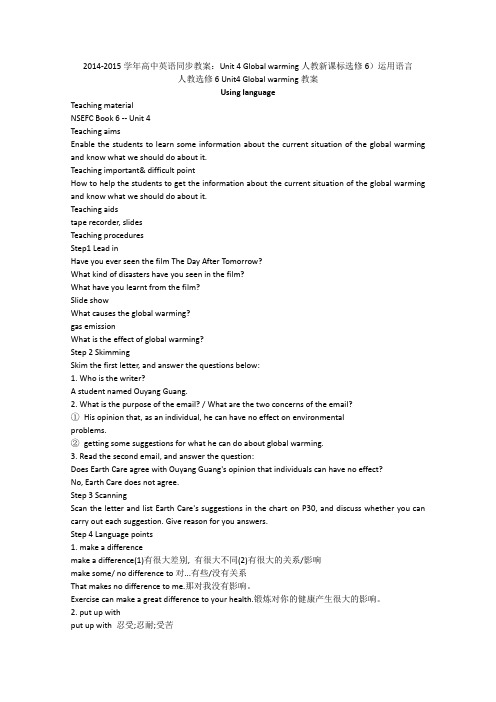
2014-2015学年高中英语同步教案:Unit 4 Global warming人教新课标选修6)运用语言人教选修6 Unit4 Global warming教案Using languageTeaching materialNSEFC Book 6 -- Unit 4Teaching aimsEnable the students to learn some information about the current situation of the global warming and know what we should do about it.Teaching important& difficult pointHow to help the students to get the information about the current situation of the global warming and know what we should do about it.Teaching aidstape recorder, slidesTeaching proceduresStep1 Lead inHave you ever seen the film The Day After Tomorrow?What kind of disasters have you seen in the film?What have you learnt from the film?Slide showWhat causes the global warming?gas emissionWhat is the effect of global warming?Step 2 SkimmingSkim the first letter, and answer the questions below:1. Who is the writer?A student named Ouyang Guang.2. What is the purpose of the email? / What are the two concerns of the email?①His opinion that, as an individual, he can have no effect on environmentalproblems.②getting some suggestions for what he can do about global warming.3. Read the second email, and answer the question:Does Earth Care agree with Ouyang Guang's opinion that individuals can have no effect?No, Earth Care does not agree.Step 3 ScanningScan the letter and list Earth Care's suggestions in the chart on P30, and discuss whether you can carry out each suggestion. Give reason for you answers.Step 4 Language points1. make a differencemake a difference(1)有很大差别, 有很大不同(2)有很大的关系/影响make some/ no difference to对...有些/没有关系That makes no difference to me.那对我没有影响。
高中英语优秀教案:Unit4《Global warming》Period 6(新人教版选修6)
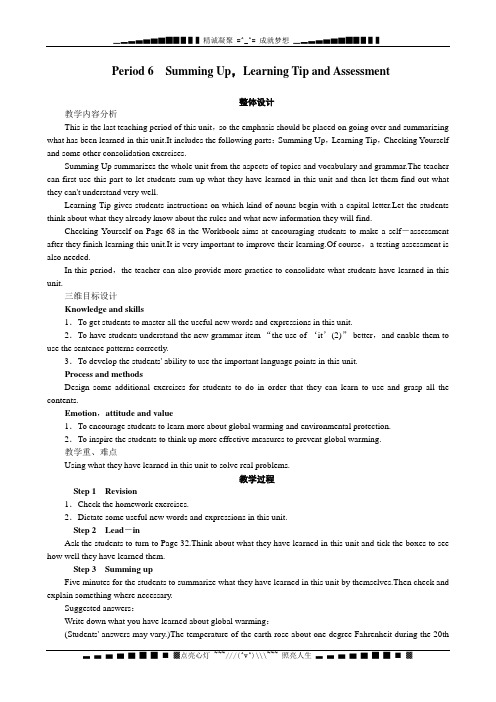
Period 6Summing Up,Learning Tip and Assessment整体设计教学内容分析This is the last teaching period of this unit,so the emphasis should be placed on going over and summarizing what has been learned in this unit.It includes the following parts:Summing Up,Learning Tip,Checking Yourself and some other consolidation exercises.Summing Up summarizes the whole unit from the aspects of topics and vocabulary and grammar.The teacher can first use this part to let students sum up what they have learned in this unit and then let them find out what they can't understand very well.Learning Tip gives students instructions on which kind of nouns begin with a capital letter.Let the students think about what they already know about the rules and what new information they will find.Checking Yourself on Page 68 in the Workbook aims at encouraging students to make a self-assessment after they finish learning this unit.It is very important to improve their learning.Of course,a testing assessment is also needed.In this period,the teacher can also provide more practice to consolidate what students have learned in this unit.三维目标设计Knowledge and skills1.To get students to master all the useful new words and expressions in this unit.2.To have students understand the new grammar item “the use of ‘it’(2)” better,and enable them to use the sentence patterns correctly.3.To develop the students' ability to use the important language points in this unit.Process and methodsDesign some additional exercises for students to do in order that they can learn to use and grasp all the contents.Emotion,attitude and value1.To encourage students to learn more about global warming and environmental protection.2.To inspire the students to think up more effective measures to prevent global warming.教学重、难点Using what they have learned in this unit to solve real problems.教学过程1Revision1.Check the homework exercises.2.Dictate some useful new words and expressions in this unit.2Lead-inAsk the students to turn to Page 32.Think about what they have learned in this unit and tick the boxes to see how well they have learned them.3Summing upFive minutes for the students to summarize what they have learned in this unit by themselves.Then check and explain something where necessary.Suggested answers:Write down what you have learned about global warming:(Students' answers may vary.)The temperature of the earth rose about one degree Fahrenheit during the 20thcentury.It is human activity that has caused this global warming.All scientists subscribe to the view that the increase in the earth's temperature is due to the burning of fossil fuels.Some byproducts of this process are called greenhouse gases,which trap heat and warm the earth.Without the greenhouse effect,the earth would be cooler than it is.But scientists don't agree with each other on the effects of global warming.Some think it will be a disaster,but some others think it's a good thing and we can do nothing to prevent the trend.By reading the second passage,we also know some easy and effective measures we can take to deal with global warming.From this unit you have also learned:Some useful words:tend,oppose,state,glance,quantity,range,tendency,circumstance,opposed,steady,widespread,average,consume,subscribe,advocate,refresh,graph,phenomenon,fuel,data,trend,catastrophe,flood,consequence,existence,commitment,pollution,growth,motor,can,microwave,educator,contribution,presentation,disagreement,random,mild,outer,electrical,casual,nuclear,per Some useful expressions:come about,subscribe to,quantities of,go up,result in,be opposed to,even if,keep on,on the whole,on behalf of,put up with,so long as,and so on,greenhouse effect New grammar item:the use of “it”—how to use “it” for emphasis in a sentence.Functional items:how to express agreement and disagreement,blame and complaint.4PracticeShow the exercises on the screen or give out exercise papers.Part 1Vocabulary1.Researchers c______ living conditions in London with those in other places.2.Their prices are low c______ to those in other shops.3.I don't think anybody m______ to her apart from herself.4.He prefers q______ to quality when food is concerned.5.The d______ we have collected are not enough to be convincing.6.Everything was in a s______ of disorder.7.What is the a______ rainfall for August in your country?8.Each i______ boy in the class has his own personalities.9.We have been having a few a______ in the committee lately.10.They were p______ in the history of music.11.As a c______ of being in hospital,Shelly decided that she wanted to become a nurse.12.A doctor has the t______ “Dr” in front of his name.13.The number of the children in the school has d______ by 500 this year.14.The cooker isn't working because of an e______ fault.15.The food was cold and the guests quarreled—the whole dinner was a c______.Part 2Useful phrases1.在20 世纪期间____________2.导致____________3.另一方面____________4.通过燃烧化石燃料____________5.大量的____________6.忍受污染____________7.有关系,有影响____________8.大体上,基本上____________9.高达5摄氏度____________10.发生____________Part 3Complete the following sentences according to the texts.1.An energy source is renewable when supplies of it never ______ ______.2.It is a rapid increase ______ ______ ______ ______ ______.3.There is ______ ______ that the earth is becoming warming but there is ______ ______ ______ whether it is ______ ______ ______has caused this global warming or whether it is ______ ______ ______ ______.4.______ the greenhouse effect,the earth ______ ______ about thirty-three degrees Celsius ______ ______ ______ ______.5.The ______ ______ of carbon dioxide ______ that more heat energy is trapped in the atmosphere ______ the ______ ______ ______ ______ ______.6.It was ______ ______ ______ Charles Keeling ______ made ______ ______ ______ the amount of carbon dioxide in the atmosphere from 1957 to 1997.7.They also believe ______ ______ the burning of more and more fossil fuels that is ______ ______ this increase in carbon dioxide.8.There are some very different ______ among scientists ______ ______ ______.9.Sometimes I feel that ______ can't have any ______ ______ ______ huge ______ problems.10.Finally and most ______,talk ______ your family and friends ______ global warming and tell them what you have learned.11.Remember—your ______ ______.Part 4Multiple choice1.Is it ______ to you that the government is having a hard time now?A.of much important B.of much consequenceC.of very importance D.of much consequent2.Something must be done to ______ the river from ______.A.stop;being polluted B.stop;pollutingC.prevent;pollution D.keep;polluted3.There ______ quantities of apples in the basket and there was ______ milk in the bucket.A.were;a number of B.was;quantities ofC.was;a good many D.were;a quantity of4.______ we get good weather it will be a successful holiday.Which is wrong?A.So long as B.Provided thatC.So long D.On condition that5.—Go for a picnic this weekend,OK?—______.I love getting close to nature.A.I don't think so B.I believe notC.I couldn't agree more D.I am afraid not6.—Now,where is my purse?—______!We will be late for the picnic.A.Come on B.Don't worryC.Take your time D.Take it easy7.It was not until 1999 ______ regular radio broadcast began.A.while B.whichC.that D.since8.Can it be in the restaurant ______ we had dinner last Sunday ______ you left your wallet?A.where;where B.where;thatC.that;where D.that;that9.—What's the matter with you?—______ the window,my finger was cut unexpectedly.A.Cleaning B.To cleanC.While cleaning D.While I was cleaning10.The other day,my brother drove his car down the street at ______ I thought was a dangerous speed.A.as B.whichC.there D.whatSuggested answers:Part 1V ocabulary1.compared pared 3.matters 4.quantity 5.data 6.state7.average8.individual 9.agreements10.phenomena11.consequence12.title13.decreased14.electrical15.catastrophePart 2Useful phrases1.during the 19th century 2.lead to 3.on the other hand 4.through the burning of fossil fuels/by burning fossil fuels 5.a great deal of/scores of 6.put up with the pollution7.make a difference8.on the whole9.as much as five degrees Celsius(5 ℃)e aboutPart 3Complete the following sentences according to the texts.1.run out pared to most natural changes 3.no doubt;fierce debate over;human activity that;just a natural phenomenon 4.Without;would be;cooler than it is 5.increased amount;means;causing;global temperature to go up 6.a scientist called;who;accurate measurements of7.it is;resulting in8.attitudes;towards this issue9.individuals;effect on such;environmental10.importantly;with;about11.contribution countsPart 4Multiple choice1~5 BADCC6~10 ACBDD5Learning tipAsk the students to turn to Page 32.Read through the passage and make sure they understand it.Encourage them to do as the passage tells because if they are doing so they will be teaching themselves a useful way of using English words.6Assessment1.Checking yourself(on Page 68 in the Workbook)First get the students to think about these questions individually.Then they can discuss in groups sharing their experience.The teacher can join in and give them advice and suggestions where necessary.2.Testing assessmentMultiple choice1.______ with the size of the whole earth,the biggest ocean does not seem big at all.A.Compare B.When comparingC.Comparing D.When compared2.Please tell me how the accident______.I am still in the dark.A.came by B.came outC.came to D.came about3.The accident ______ the death of two passengers.A.resulted from B.resulted inC.resulted of D.resulted with4.It is in the west of China ______ there is no doubt ______it is going to rain tomorrow.A.where;whether B.that;thatC.that;whether D.where;that5.It was 1969______ the American astronauts succeeded in landing on the moon.A.that B.whenC.on which D.which6.It was ______ back home after the experiment.A.not until midnight did he goB.until midnight that he didn't goC.not until midnight that he wentD.until midnight when he didn't go7.There's some doubt ______he'll keep his promise.A.whether B.ifC.that D.which8.The ______ parents were all ______for the children's safety.A.concerned;concernedB.concerned;concerningC.concerning;concerningD.concerning;concerned9.The students ages ______ 15 to 18.A.range B.rangedC.range from D.ranges from10.______,we'll go camping.A.Weather permits B.If weather will permitC.Weather permitting D.Weather permitted11.______,we would have not finished the work on time.A.If you didn't help us B.Without your helpC.Without you D.With your help12.—I will not come here tomorrow.—______to me,because I don't care.A.It doesn't make any differenceB.It makes much differenceC.It doesn't make no differenceD.It makes a difference13.You can go out,______you promise to be back before 11 o'clock.A.as far as B.so far asC.when D.as/so long as14.—I apologize for not being able to join you for dinner.—______.We'll get together later.A.Go ahead B.Not to worryC.That's right D.Don't mention it15.Christmas is ______ special holiday when ______ whole family are supposed to get together. A.the;the B.a;aC.the;a D.a;theSuggested answers:1~5 DDBBB6~10 CAACC11~15 BADBD7Homework1.Finish off the Workbook exercises.2.Review and summarize what you have learned in Unit 4.8Reflection after teaching________________________________________________________________________________________________________________________________________________。
- 1、下载文档前请自行甄别文档内容的完整性,平台不提供额外的编辑、内容补充、找答案等附加服务。
- 2、"仅部分预览"的文档,不可在线预览部分如存在完整性等问题,可反馈申请退款(可完整预览的文档不适用该条件!)。
- 3、如文档侵犯您的权益,请联系客服反馈,我们会尽快为您处理(人工客服工作时间:9:00-18:30)。
2014-2015学年高中英语(重庆)同步教案(7):Unit 4 Global warming 人教新课标选修6)相关背景资料Global warming may be twice as bad as fearedThe impact of global warming could be twice as severe as the worst scenario feared by United Nations scientists, the world’s largest climate-modelling experiment has shown.Average temperatures could rise by 11℃(20) to reach highs that would change the face of the globe, researchers who have run 60,000 computer simulations of climate change said yesterday. The conclusions suggest that forecasts by the UN’s Intergovernmental Panel on Climate Change (IPCC) may be much too conservative. In the worst case, the world would eventually heat up by almost double the maximum increase envisaged by the panel. The IPCC’s latest report predicted that temperatures will rise by between 1.4℃(2.5) and 5.8℃(10.4) by 2100.A world 11℃warmer than it is today would be unrecognisable: while records show that the planet has been hotter than it is today for about 80 per cent of its history, there is no evidence that it has ever been more than about 7℃warmer.Although it would take hundreds of years for the full effects to be felt, the polar ice caps eventually would melt completely, causing sea levels to rise by 70m to 100m (230ft to 330ft). Coastal and low-lying cities such as London and New York would be submerged.As the 11℃figure is a global average, temperatures would be expected to climb even further in some regions.David Stainforth, of the University of Oxford, the study’s chief scientist, said: “When I start to look at these figures, I get very worried about them. An 11-degree warmed world would be a dramatically different world.”Global warmingAccording to the National Academy of Sciences, the Earth’s surface temperature has risen by about 1 degree Fahrenheit in the past century, with accelerated warming during the past two decades. There is new and stronger evidence that most of the warming over the last 50 years is attributable to human activities.Human activities have altered the chemical composition of the atmosphere through the buildup of greenhouse gases —primarily carbon dioxide, methane, and nitrous oxide. The heat-trappingproperty of these gases is undisputed although uncertainties exist about exactly how earth’s climate responds to them.Energy from the sun drives the earth’s weather and climate, and heats the earth’s surface; in turn, the earth radiates energy back into space. Atmospheric greenhouse gases, such as water vapor, carbon dioxide, trap some of the outgoing energy, retaining heat somewhat like the glass panels of a greenhouse.Without this natural “greenhouse effect”, temperatures would be much lower than they are now, and life as known today would not be possible. Instead, thanks to greenhouse gases, the earth’s average temperature is a more hospitable 60°F.However, problems may arise when the atmospheric concentration of greenhouse gases increases. Once, all climate changes occurred naturally. However, during the Industrial Revolution, we began altering our climate and environment through changing agricultural and industrial practices. Before the Industrial Revolution, human activity released very few gases into the atmosphere, but now through population growth, fossil fuel burning, and deforestation, we are affecting the mixture of gases in the atmosphere.Carbon dioxide is released to the atmosphere when solid waste, fossil fuels and wood products are burned. Methane is emitted during the production and transport of coal, natural gas, and oil. Methane emissions also result from the decomposition of organic wastes in municipal solid waste landfills, and the raising of livestock. Nitrous oxide is emitted during agricultural and industrial activities, as well as during combustion of solid waste and fossil fuels.Rising global temperatures are expected to raise sea level, and change precipitation and other local climate conditions. Changing regional climate could alter forests, crop yields, and water supplies. It could also affect human health, animals, and many types of ecosystems and deserts may expand into existing rangelands. Unless we act now, our children will inherit a hotter world, dirtier air and water, more severe floods and droughts, and more wildfires.But solutions are in sight. We know where most heat-trapping gases come from: power plants and vehicles. And we know how to curb their emissions: modern technologies and stronger laws. By shifting the perception of global warming from abstract threat to pressing reality, and promoting online activism. By pressing businesses to use less energy and build more efficient products. And by fighting for laws that will speed these advances.What is Clean Up Australia DayEvery year hundreds of Australians help clean up their local environment on Clean Up Australia Day. It’s easy, fun and everyone can take part.Individuals, local groups and schools can either organise a Clean Up site, or volunteer to join an existing site.So why not do your bit for the environment and get involved next year?Clean Up Australia Day in 2005Across the country over 670,000 volunteers removed more than 8,450 tonnes of rubbish from our beaches, parks, streets, bush land and waterways as part of Clean Up Australia Day, the nation’s largest community based environmental event.Families, friends, neighbours, businesses and community groups spent the equivalent of 62,163 days, at over 7,000 sites, removing rubbish ranging from car bodies and electronic waste tothousands of chip packets, drink bottles, plastic bags and cigarette butts.Speaking from the Clean Up Australia Day site in Taren Point, Sydney, Ian Kiernan AO, Chairman && Founder of Clean Up Australia, praised volunteers and site organisers around the country.“Taren Point captures perfectly the real long term benefits of Clean Up Australia Day and reinforces that Clean Up is more than just one day. Volunteers at Taren Point have begun to transform a rubbish dump, polluting the delicate salt marshes, back into a natural recreational area for us all to enjoy,” Mr Kiernan said.“Congratulations to the thousands of volunteers who spent their time removing packaging waste and illegally dumped items from the environment today. Their actions show government and industry that Australians do care about the environment.” he continued.At this stage, the country’s most polluted sites appear to be roadways followed by parks, waterfronts and coastal areas.Some of the amazing accomplishments of volunteers during this year’s campaign include the clean up of 1,545 roadsides, 738 parks and 1,387 waterways and coastal areas.Weird and interesting items collected around the country today include an unopened slab of beer and a bottle of whiskey, two headless garden statues, a bride’s veil, an electric guitar, a plastic monkey and a chair up a tree.The most common rubbish items found were plastic and glass bottles, chip and confectionary packets, plastic bags and cigarette butts.“Sadly these rubbish items continue to end up in the environment when plastic containers should be recycled, cigarette butts shoul d be binned and we should all being saying no to plastic bags,” Mr Kiernan said.“It is estimated that only 20% of plastic packaging is recycled, this is far below paper recycling at 80%. This is not good enough and I urge government and industry to take action immediately by setting strong targets for the National Packaging Covenant and investing more resources to address this issue,” he continued.The Clean Up Australia Day campaign is one time during the year when Australians get physical about cleaning up the environment. It also provides the platform to implement positive environmental practices every day of the year.Australians can continue to clean up by supporting Clean Up Australia’s Say No to Plastic Bags and Personal Ashtray campaigns, the Mobile Phone Recycling program and by making use of the new computer and electronics recycling initiative recently established by Collex, Major Sponsor of Clean Up Australia Day.。
